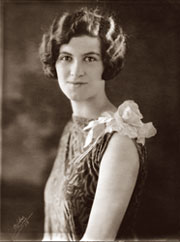by Bruce Lyndes
It was the spring of 1923. Ford’s Model “T” was the nation’s most popular car, Time magazine’s first issue hit the newsstands, and a young cartoonist named Walt Disney was starting a company in California. Back in New England, Plymouth, N.H., was a bustling community with a busy train station, a thriving wood products industry and Plymouth Normal School, which prepared young people to be teachers for $100 in annual tuition.
For virtually anyone reading this, these are historical facts to read about or see preserved in a museum. But for one Dorchester, N.H., woman, it’s still a crystal clear memory of her life. At 103, Margaret Brown Ouellet is the oldest alumna of Plymouth Normal School, which became Plymouth Teachers College, Plymouth State College, and, finally, Plymouth State University. Her recollections of life at this institution in the 1920s are a remarkable glimpse into the past, tempered by a unique insight and perspective.
The school had a handful of buildings, with just over 100 students, most living in Mary Lyon Hall and taking classes in Rounds Hall, overseen by Herbert Lamson and Dr. Ernest Silver. There were no specialized courses or majors, just a basic preparatory education that would enable graduates to teach all grades, simultaneously, in one- or two-room schools, then the norm in rural New Hampshire.
Twenty-year-old Margaret Brown was a good student and aspiring teacher, living at her family’s Langdon Street home and earnestly striving to finish her studies. Ouellet remembers Dr. Silver as a stern but understanding leader, whose presence commanded attention and respect. She recalls sitting in Rounds Hall with most of the school’s students, as Dr. Silver strode in, his eyes glaring. He rebuked the class about morals, and out of the corner of her eye, Ouellet noticed two female classmates hanging their heads in shame. Their scandalous behavior?
“They had smoked a cigarette,” said Ouellet.
Ouellet also recalls Silver’s strict oversight of Mary Lyon Hall.
“Between the hours of 7 and 9 p.m., you had to study. Between 9 and 10 p.m., you could socialize, but the doors were locked, so no one could go out into the community,” said Ouellet. “I also remember some of the young men in town would try to pass letters to the girls in Mary Lyon, by slipping the messages through windows, but Dr. Silver would intercept them, and lecture the girls about it.”
A night out in town might include a 15-cent hot dog at Minickiello’s Diner on Main Street, near the spot where the Rand’s hardware store now stands.
Ouellet graduated from Plymouth Normal School in 1924, and landed a teaching job in Campton, with a starting salary of $850 a year. “I taught four grades in that school. I was lucky to get that job,” Ouellet said. “In those days teachers would stay on for as long as possible, because there was no social security back then. You had to teach until you couldn’t stand up.” She also spent a year teaching in a one-room school in Sandown.
As a single teacher of modest means, she would get a ride home in a horse and buggy with a couple of her pupils. She recalls one afternoon in Sandown when a sudden thunderstorm struck while the two children were getting out of the buggy in their family’s barn.
“A lightning bolt came through the roof just a few feet away,” Ouellet recalled. “It was very frightening, though no one was hurt. It’s something I never forgot.”
By 1928, Margaret Brown married Frank Ouellet, a steam fitter at the Draper Manufacturing Company in Beebe River, a bobbin manufacturer. The young wife also started working there as a bobbin inspector, earning more money and job security than the life of a small-town teacher could offer.
Ouellet said she doesn’t regret any decisions she’s made with her life, with one exception: “I never learned to drive. If I had to live over again, that’s one thing I would learn to do.”
Margaret Brown Ouellet is the mother of two, grandmother of two, great grandmother of five and great-great grandmother of four. Her long and rich life and the extraordinary memories she shares are a treasured part of Plymouth State University’s past.









